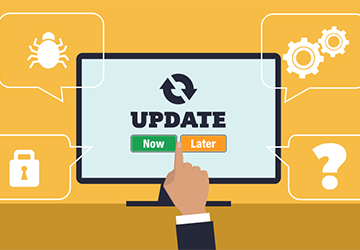Today's business world is increasingly becoming digital, with most operations relying on various software applications. With this in mind, considering Timing Software Updates is more crucial than ever. Failing to update your software can result in minor glitches and open avenues for significant security vulnerabilities. Likewise, updating without adequate preparations can disrupt business operations. This article serves as an all-encompassing guide to walk you through the crucial aspects of Updating Company Software and how to create an efficient Software Update Schedule.

Timing Software Updates is more complex than it may appear. Companies often face the dilemma of when to hit that 'update' button. Update too soon, and you might find your staff struggling with new features they weren't unprepared for. Wait for too long, and you expose yourself to security risks that could have been easily avoided. The ideal way to balance this is to have a dedicated team or individual review, test, and approve any new software updates.
The scheduling of software updates often has far-reaching implications for the day-to-day operations of a business. As such, aligning these updates with your business cycle's natural ebbs and flows is beneficial. For example, retail companies might find it most convenient to implement updates during the off-season when there's less customer activity. Such meticulous planning minimizes operational disruptions and facilitates a smoother transition, thus making your Software Update Schedule an integrated part of your business plan.
Not all software updates are created equal. Some updates aim to plug in security holes and should be applied as soon as they are available. The critical Importance of IT Security cannot be overstated in this context. In contrast, others bring in new features or functionalities that your team might need to adapt. Knowing the differences is crucial for a successful update strategy. Therefore, evaluating the updated goals and planning the launch process is necessary.
Updating Company Software isn't just about internal considerations. The external market dynamics, primarily actions taken by your competitors, can necessitate quicker updates. If your competitors are leveraging newer technologies to streamline operations, improve customer service, or offer something new, then sitting back and ignoring updates can cost you valuable market share. Market analysis should be a vital element in deciding your Software Update Schedule.
Setting a company-wide software update policy can remove a lot of ambiguities and inefficiencies from the process. Such a policy guides how different kinds of updates should be managed, ensuring a systematic approach to how new software versions are rolled out across the company; this is especially crucial in larger organizations where updates may have varying impacts on different departments.
Another essential aspect to consider in Updating Company Software is the cost-benefit analysis. While it's easy to be swayed by a software update's latest features, businesses must weigh these benefits against the costs involved. These could range from the actual price of the update, if it's not free, to the time and effort required to train employees on new features. An in-depth cost-benefit analysis ensures that the decision to update isn't just about having the latest features, improving operational efficiencies, and meeting strategic objectives.
The Software Update Schedule doesn't stop at the click of a button. Once an update is rolled out, the human element comes into play. Employees across different departments will need time to adapt to new features or changes in the software interface. This adaptation period could lead to temporary drops in productivity, which must be factored into the overall update strategy. Organizations often overlook this human aspect, focusing solely on the technical side. Proper training programs must be in place to mitigate these issues and help employees adapt more rapidly to the new software environment.

While the Importance of IT Security in software updates can't be understated, what happens when an update fails or leads to unexpected problems? A contingency plan, or a rollback strategy, should be an integral part of any software update policy; this ensures that businesses can quickly revert to previous software versions without significant disruptions if an update fails to deliver on its promises or introduces new vulnerabilities.
As companies collect and store vast amounts of data, any software update must be scrutinized for how it impacts data privacy and compliance, especially in regulated industries. Businesses have an ethical and often legal obligation to protect customer data. Therefore, part of the Software Update Schedule should involve a thorough review of how the update impacts data security and whether it complies with existing laws and regulations. This extra layer of scrutiny is more than just good practice.
Companies should think about more than just the next update but have a long-term roadmap; this involves tracking the release cycles of their software and aligning them with their operational processes. It's not just about solving immediate issues but also about future-proofing the business. A long-term view ensures that the software updates support the company's.
In sum, updating company software is far from a routine, technical task—it is a complex process that requires strategic planning, cost-benefit analysis, and a focus on both the human and ethical dimensions. Therefore, having a well-thought-out Software Update Schedule that aligns with business goals, considers the human factor, and incorporates ethical considerations is essential. By doing so, companies can turn software updates from a technical chore into a strategic advantage.